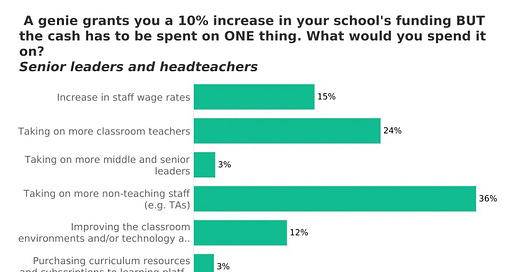Are Teaching Assistants Worth It?
What Teachers Say
This is what Teacher Tapp asked and discovered.
Teachers are lovely people. They would rather spend money on a TA than on themselves!
They also believe that TAs have a bigger impact than spending the money on other teachers.
What is behind this self deprecation?
Teachers are struggling with SEND in their lessons. Hiring more teachers won’t change that - but they hope having a TA present will.
But is that hope pie in the sky?
What the EEF Toolkit says about TA Support in the Classroom
Those numbers, 0 and 5, refer to the extra months of progress. That’s right, having a TA in your classroom leads to no extra learning.
They might as well not be there.
In fact, many students would learn more if the TA was not there:
“Research that examines the impact of teaching assistants deployed in everyday classroom environments suggests that students in a class with a teaching assistant present do not, on average, outperform those in one where only a teacher is present. This average finding covers a range of effects. In some cases, teachers and teaching assistants work together effectively, leading to increases in attainment. In other cases, pupils, particularly those who are low attaining or identified as having special educational needs, can perform worse in classes with teaching assistants.
Where overall negative effects have been recorded, it is likely that support from teaching assistants has substituted rather than supplemented teaching from teachers.
In the most positive examples, it is likely that support and training will have been provided for both teachers and teaching assistants so that they understand how to work together effectively, such as by making time for discussion before and after lessons.”
How to Use a Classroom TA More Effectively
This is not the TA’s fault.
Let’s face it, there is not enough time for you to regularly meet with your TA. So difficult that the writers at the EEF have never seen it, which is why they say “it is likely that” - they’re having to guess.
But here’s how you can do it in only 5 minutes per half term.
Write a list of the learning needs and barriers of your SEND student.
Write a list of the ways the TA can help with these and (crucially) what will not help.
Decide how you or the TA will measure how far the students is overcoming those needs.
Include how the TA will keep you involved - you will probably default to teaching the class and letting the TA get on with it - I know I would - and we both know that is not their job. But finding the time to keep checking in is hard. So, decide on how and when the TA will summon you if you have forgotten to check in.
Film yourself on your phone, using these lists as prompts. Begin the video by saying how much you appreciate the impact your TA is having on the student already.
My experience is that this video will last around 90 seconds.
It is then easy for the TA to watch it, and for you to check in every lesson to see how the student is doing in relation to those barriers.
If you would like dozens of other ways to get more progress for your students, without working harder, you can find them in my book:
If you are an English teacher, this one is much more specific:







